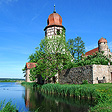WARTBURG CASTLE
Martin Luther, His Bible, His Devil and a Saint
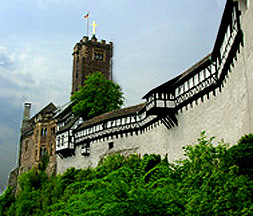 Leave a man alone in his room with a pen and inkwell and he can change the world. After his refusal to recant his views in opposition to the Catholic Church’s selling of indulgences at the Diet of Worms in 1521 (see Cathedral
at Worms),Martin Luther hid out at Wartburg Castle in the Thuringian forest town of Eisenach. Luther had lived briefly in the town of Eisenach under his own name, but while staying in a lonely small room at the end of the guard’s walk at Wartburg Castle, the exiled former monk hid out under the name of “Junker Jörg” (The Knight George). He spent his time translating the Latin bible into German, creating the “Luther Bible” (see Luther 500 Years at Wartburg).
Leave a man alone in his room with a pen and inkwell and he can change the world. After his refusal to recant his views in opposition to the Catholic Church’s selling of indulgences at the Diet of Worms in 1521 (see Cathedral
at Worms),Martin Luther hid out at Wartburg Castle in the Thuringian forest town of Eisenach. Luther had lived briefly in the town of Eisenach under his own name, but while staying in a lonely small room at the end of the guard’s walk at Wartburg Castle, the exiled former monk hid out under the name of “Junker Jörg” (The Knight George). He spent his time translating the Latin bible into German, creating the “Luther Bible” (see Luther 500 Years at Wartburg).
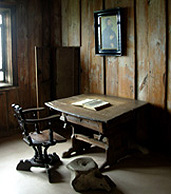 The translation, suggested by his friend Melanchthon took 11 weeks to complete, finished after he had left the castle confines. It seems that the stay was a rough time for Luther, fighting the inner demons of depression, while outwardly fighting the Devil. The Lutherstube (Luther’s Room) at Wartburg castle no longer contains the original furniture when Luther was there, except for a curious whale bone seat, but has been recreated. The one piece not replaceable was the famous ink stain on the wall where Luther was said to have flung his inkwell at the devil. He apparently missed because the devil is surely still around, but the ink stain has been chipped away over the centuries by souvenir hunters, so it is now mostly a hole in the plaster.
The translation, suggested by his friend Melanchthon took 11 weeks to complete, finished after he had left the castle confines. It seems that the stay was a rough time for Luther, fighting the inner demons of depression, while outwardly fighting the Devil. The Lutherstube (Luther’s Room) at Wartburg castle no longer contains the original furniture when Luther was there, except for a curious whale bone seat, but has been recreated. The one piece not replaceable was the famous ink stain on the wall where Luther was said to have flung his inkwell at the devil. He apparently missed because the devil is surely still around, but the ink stain has been chipped away over the centuries by souvenir hunters, so it is now mostly a hole in the plaster.
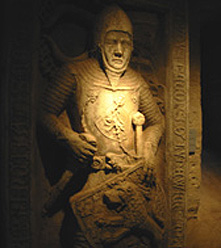 Wartburg Castle has been referred to as one of the best preserved castles in Germany and a symbolic one. The castle was built in 1067 by a Count (Landgrave) Ludwig of Thuringia. Much of the early Romanesque portions of the castle palace remain, making it one of the few palaces of that period extant in German. The castle was restored with great attention to detail and added to with romantic revival elements in the 19th Century by architect Hugo von Ridgen. A detailed book of plans and progress of the restoration of Wartburg Castle can be found at the Castles Institute in Schloss Philippsburg over along on the Rhine (see Philippsburg
). The book is also in the museum of Wartburg, but behind glass.
Wartburg Castle has been referred to as one of the best preserved castles in Germany and a symbolic one. The castle was built in 1067 by a Count (Landgrave) Ludwig of Thuringia. Much of the early Romanesque portions of the castle palace remain, making it one of the few palaces of that period extant in German. The castle was restored with great attention to detail and added to with romantic revival elements in the 19th Century by architect Hugo von Ridgen. A detailed book of plans and progress of the restoration of Wartburg Castle can be found at the Castles Institute in Schloss Philippsburg over along on the Rhine (see Philippsburg
). The book is also in the museum of Wartburg, but behind glass.
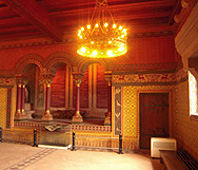 Wartburg Castle has a significance that goes much beyond its Luther history connection. Adolph Hitler considered it one of the “most German of castles” and the local town authorities had to battle with him like Luther with his devil when Wagnerian enthusiast Hitler wanted to replace the castle’s Christian cross with a Swastika. One of the most impressive rooms within the castle is the Singers Hall (Sängersaal) or Hall of Minstrels, immortalized by Richard Wagner’s opera “Tannhäuser”, where in the middle ages, a contest of poets and minstrels was regularly held at Wartburg castle. Wagner took some poetic license of his own and set the action of the second act of his opera here. Wartburg and its Wagnerian Germanic identity also inspired "Mad" King Ludwig of Bavaria when he decided he needed a mountain top castle of his own (see Ludwig's
Fantasy Castle Neuschwanstein).
Wartburg Castle has a significance that goes much beyond its Luther history connection. Adolph Hitler considered it one of the “most German of castles” and the local town authorities had to battle with him like Luther with his devil when Wagnerian enthusiast Hitler wanted to replace the castle’s Christian cross with a Swastika. One of the most impressive rooms within the castle is the Singers Hall (Sängersaal) or Hall of Minstrels, immortalized by Richard Wagner’s opera “Tannhäuser”, where in the middle ages, a contest of poets and minstrels was regularly held at Wartburg castle. Wagner took some poetic license of his own and set the action of the second act of his opera here. Wartburg and its Wagnerian Germanic identity also inspired "Mad" King Ludwig of Bavaria when he decided he needed a mountain top castle of his own (see Ludwig's
Fantasy Castle Neuschwanstein).
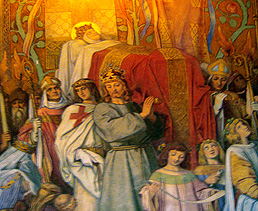 In curious antithesis to its connection to Lutheran Protestantism, Wartburg Castle was also the home of a Roman Catholic Saint - Elizabeth of Hungary who was brought to Wartburg at the age of 4 and became the consort of Thuringian Count Ludwig IV. After his death, she became devoted to charity and was responsible for enough miracles to be canonized after her own early death, and made Saint Elizabeth (see Hofkirche Innsbruck). Her chambers at the castle are one of the focuses of a tour through the Romanesque palace where the rooms are mostly devoid of furniture, with the wonderful medieval art motifs of the walls remain the only reminder of the grandeur of the times. One of the striking wall paintings is of the burial procession of the death of St. Elizabeth.
In curious antithesis to its connection to Lutheran Protestantism, Wartburg Castle was also the home of a Roman Catholic Saint - Elizabeth of Hungary who was brought to Wartburg at the age of 4 and became the consort of Thuringian Count Ludwig IV. After his death, she became devoted to charity and was responsible for enough miracles to be canonized after her own early death, and made Saint Elizabeth (see Hofkirche Innsbruck). Her chambers at the castle are one of the focuses of a tour through the Romanesque palace where the rooms are mostly devoid of furniture, with the wonderful medieval art motifs of the walls remain the only reminder of the grandeur of the times. One of the striking wall paintings is of the burial procession of the death of St. Elizabeth.
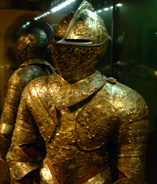 While Eisnenach was a symbol of German unification in the 1800s for its gathering of protesting students in 1817, demanding the unifying of disparate fiefdoms into a modern German nation, the Burschenschaften, the town and its famous castle rather suffered the worse for the division of Germany into east and west after WWII. The castle’s once great armor collection was looted by the Russians and its furnishings vanished under East German control. A few pieces remain in the museum. The city of Eisenach itself became an industrial town during the East German years, known for the manufacture of an East German car named for it. Today, Eisenach still retains some of it industrial feel, but the old town center has a square of historic half-wood buildings and stone medieval period gate house remaining from the city walls.
While Eisnenach was a symbol of German unification in the 1800s for its gathering of protesting students in 1817, demanding the unifying of disparate fiefdoms into a modern German nation, the Burschenschaften, the town and its famous castle rather suffered the worse for the division of Germany into east and west after WWII. The castle’s once great armor collection was looted by the Russians and its furnishings vanished under East German control. A few pieces remain in the museum. The city of Eisenach itself became an industrial town during the East German years, known for the manufacture of an East German car named for it. Today, Eisenach still retains some of it industrial feel, but the old town center has a square of historic half-wood buildings and stone medieval period gate house remaining from the city walls.
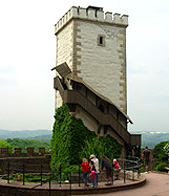 The
Castle of Wartburg sits high on a mountain cliff above the town with
great views of the Thuringia forested countryside, some of the most
beautiful woods in Germany. Wartburg castle was designated
as a UNESCO World Heritage site in 1999 and is a very popular tourist
destination for its historic and religious importance. It can get very
crowded on weekends or summer holiday periods. A guided tour is required
to see inside the old palace and museum, but part of the grounds and
courtyard can be wandered without paid admission. Luther’s
Room is after the tour and climbing the winding wooden staircase of
the
medieval
south tower affords a view of the castle and the surrounding forests.
The
Castle of Wartburg sits high on a mountain cliff above the town with
great views of the Thuringia forested countryside, some of the most
beautiful woods in Germany. Wartburg castle was designated
as a UNESCO World Heritage site in 1999 and is a very popular tourist
destination for its historic and religious importance. It can get very
crowded on weekends or summer holiday periods. A guided tour is required
to see inside the old palace and museum, but part of the grounds and
courtyard can be wandered without paid admission. Luther’s
Room is after the tour and climbing the winding wooden staircase of
the
medieval
south tower affords a view of the castle and the surrounding forests.
Visiting Wartburg Castle & Luther Stube
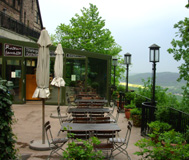 There is a restaurant at Wartburg Castle with a terrace view for a
snack
or lunch, or if you don’t feel like sitting, when heading back
to the car or town stop for a real Thuringia sausage. There is a car
park
near the castle, which can be filled at busy times. Busses line up
underneath the walking bridge to the castle gates. From the city without
a car the
castle can be reached by a half-hour marked walk up the wooded hill
There is a restaurant at Wartburg Castle with a terrace view for a
snack
or lunch, or if you don’t feel like sitting, when heading back
to the car or town stop for a real Thuringia sausage. There is a car
park
near the castle, which can be filled at busy times. Busses line up
underneath the walking bridge to the castle gates. From the city without
a car the
castle can be reached by a half-hour marked walk up the wooded hill
Should you have a desire to live like a count yourself while touring
the seat of Thuringian Landgraves, there is a luxury hotel connected
to Wartburg Castle on the mountaintop, the Hotel
Auf Der Wartburg, which
announces its five stars with a private drive and offering means to
stay at a German Castle that is far from the ascete's chamber Martin
Luther
endured during his stay, but at reasonably monkish price. For the
European travel bargain hunter, since the former east of Germany has
yet to catch
the
economy
of the
west,
the prices can offer a bit of savings. In the town center is one of
the Stiegenberger chain of Germany deluxe hotels the Hotel
Thuringer Hof,
with a very Protestant priced room rate.
Eisenach
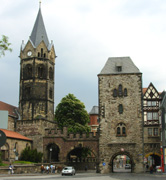 Aside
from the famous historic castle, the city of Eisenach was also the
birthplace of Johann Sebastian Bach (Bachhaus), though he spent most of his life in Leipzig (see Bach Museum Leipzig). The Luther House
where the Reformation leader lived for a time holds a number of
Luther history artifacts and there is also an auto museum dedicated the city's
DDR period
car manufacturing
history. Eisenach lies on the rail and A4 autobahn route from Hessen
Frankfurt or Kassel to Erfurt and Dresden or Berlin. The city is about
an hour drive from Weimar to the east or Marburg to the west. For more
of Martin Luther, head over to Wittenberg south of Berlin (see Lutherstadt
Doors of the Castle Church). © Bargain
Travel Europe
Aside
from the famous historic castle, the city of Eisenach was also the
birthplace of Johann Sebastian Bach (Bachhaus), though he spent most of his life in Leipzig (see Bach Museum Leipzig). The Luther House
where the Reformation leader lived for a time holds a number of
Luther history artifacts and there is also an auto museum dedicated the city's
DDR period
car manufacturing
history. Eisenach lies on the rail and A4 autobahn route from Hessen
Frankfurt or Kassel to Erfurt and Dresden or Berlin. The city is about
an hour drive from Weimar to the east or Marburg to the west. For more
of Martin Luther, head over to Wittenberg south of Berlin (see Lutherstadt
Doors of the Castle Church). © Bargain
Travel Europe
Find best hotel and vacation deals in Eisenach on TripAdvisor
Web Info
Wartburg Castle
These articles are copyrighted and the sole property of Bargain Travel Europe and WLPV, LLC. and may not be copied or reprinted without permission.
See Also:
WALKING & CYCLING
THE LUTHER ROUTE
GERMANY'S
CASTLE ROAD
SCHLOSS LUDWIGSECK - CASTLE B&B HESSEN
CASTLE
HOTEL KÖNIGS WUSTERHAUSEN BRANDENBURG
HOMBERG
EFZE - REFORMATION AND REVOLUTION
ROCHLITZ CASTLE - SAXONY REFORMATION

